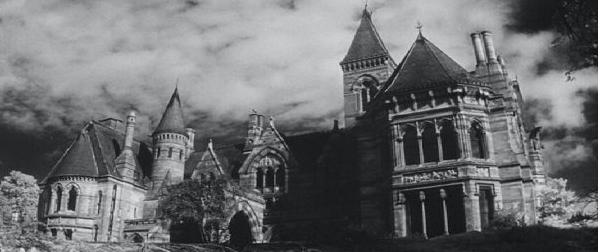Halloween Horror: The Haunting (1963)
The Haunting, directed by Robert Wise and based on the novel by Shirley Jackson, is a masterfully-directed post-Psycho Gothic horror film that gets into your head with its compelling psychological drama. The 1963 film tells the story of Hill House, a sprawling New England mansion (exteriors shot at Ettington Park in England) with a history of strange and violent deaths. Built in the 19th century by one Hugh Crain, the mysterious events began when Crain’s wife died when her carriage crashed into a tree. His second wife died in the house by falling down the stairs. His daughter remained in the house, though her paid companion hung herself. Thereafter, the house passed on to a Mrs. Sanderson. Now, 90 years later, Dr. Markaway (Richard Johnson) hopes to use the house in his experiment to prove the existence of the supernatural.
The story proper begins when Dr. Markaway invites a number of individuals with previous experience with the paranormal, to Hill House for the experiment. Out of the invitees, only two women accept and arrive for the study: the psychic Theodora, or Theo (Claire Bloom), whose barely-veiled queer sexuality was a rarity on screen at the time, and Eleanor, or Nell, (Julie Harris), a fragile woman for whom Hill House represents an escape from family traumas. Accompanying the doctor and two women is the heir to the house, Luke Sanderson (Russ Tamblyn), who doesn’t believe in the paranormal but does believe the stories might actually be good for the real estate price.
Once the characters are assembled at the house, the creepiness quickly begins. Theo and Nell hear strange sounds in the hallways, doorknobs turn on their own, and Nell especially feels the presence of something around her. Dr. Markaway approaches all of this with the distance of a clinician, but even he warns the women to stay away from the nursery at the center of the house. An inexplicable cold spot outside the locked door of the nursery suggests that it is the focal point of whatever occupies the house.
The Haunting is interesting in how it merges the exploration of the supernatural with the psychological in the wake of Psycho, from three years earlier, which posited that the damaged human psyche was equally capable of horrifying acts as supernatural forces. Nell herself is kind of a more fragile and damaged version of Marion Crane from Psycho; the scene of her flight from her sister’s home to Hill House plays like Marion’s attempt to escape Phoenix. Yet Nell is also more than a little like Norman Bates as well; it’s not always clear which of the spooky events of the film are actually happening and which are the product of her damaged mind. Julie Harris’s performance, damaged and disturbed, is part of the effect of the film. Apparently Harris herself was depressed and paranoid during the filming, and it shows on screen, awful as the experience must have been.
Director Robert Wise had originally sought to adapt Shirley Jackson’s novel as a straight psychological thriller, with the haunting of Hill House the products of Nell’s psychosis. While Jackson herself apparently told Wise that in her mind the story explored real supernatural terror, the film retains an ambiguity that actually serves it well. Even if one easily dismisses ghosts and ghouls, The Haunting never relies on shock value or showing us the supernatural for its horror, but rather the increasing psychological distress of the house’s inhabitants. Nell’s depressive state begins to transfer to an identification with Hill House and a desire to stay in the house, against all evidence that it is a bad idea. The horror of The Haunting is about the terrifying bond between people and their own traumas, and the devastating consequences.
If there is a central supernatural idea to The Haunting it is that places and locations can become impressed with the trace of past events that occur there. This is why Wise making Hill House itself a kind of character in the film, its elaborate sets and props shot with an eye to off-kilter and warped views, through a variety of canted angles and fish-eye lenses, and filling the soundscape with a cacophony of creepy sound effects is so important. Few haunted houses in cinema resonate and take on the character of Hill House. Wise’s shot selection never provides the viewer with a clear understanding of the house’s geography, making it all the more confounding, yet frightening.
The Haunting is a classic of the horror genre, and shows how directors began to adapt the gothic genre to the psychological motivation of Psycho. Wise’s previous work with Val Lewton, helming the sequel film, Curse of the Cat People, served him well, as he learned on a low budget how to maximize his sets and actors rather than rely on explicit expressions of horror. His earlier lessons bear fruit in The Haunting. It’s a top-tier horror experience.
The Haunting (1963, UK/USA)
8 out of 10
Directed by Robert Wise; screenplay by Nelson Gidding, based on the novel The Haunting of Hill House by Shirley Jackson; starring Julie Harris, Claire Bloom, Richard Johnson, Russ Tamblyn, Lois Maxwell, Rosalie Crutchley, Valentine Dyall.
